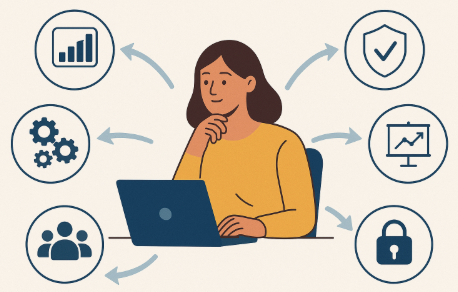Aligning Dynamics 365 with Long-Term Goals
By Michelle Serna, TruNorth Dynamics
Enterprise Resource Planning (ERP) systems are the backbone of many organizations, centralizing data, automating processes, and supporting strategic decision-making. But as the business environment continues to shift—technologically, economically, and globally—it’s not enough for an ERP system to simply meet your current needs. To remain competitive and resilient, businesses must build future-proof ERP strategies that evolve with them.
This article explores the core principles of creating an ERP strategy that aligns with your organization’s long-term goals, with practical insights into how platforms like Microsoft Dynamics 365 support this journey.
1. Understand the Strategic Role of ERP in Your Organization
Before selecting features or modules, it’s essential to clearly define how ERP fits into your overall business strategy. This means identifying both:
Current challenges: Manual processes, data silos, compliance issues, etc.
Future objectives: Expansion plans, service diversification, digital transformation, or new operating models.
Treat your ERP system not just as an operational tool but as a strategic enabler—one that can help you pivot quickly, support innovation, and scale with your growth trajectory.
Tip:
Map out your business goals for the next 3–5 years, then link those goals to specific ERP capabilities. For example, if international expansion is a goal, your ERP must support multi-currency and multi-entity operations.
2. Design for Flexibility, Not Just Fit
Many ERP implementations focus on solving today’s pain points. While that’s important, future-proof strategies prioritize adaptability.
Modern ERP systems like Dynamics 365 use a modular architecture, which means you can implement what you need now and scale up as your business evolves. You’re not locked into one structure—new capabilities can be added as needed.
Tip:
Avoid over-customizing from day one. Instead, adopt a “configure over customize” mindset. This keeps your system agile, easier to maintain, and ready for updates and new use cases.
3. Incorporate Data and Analytics from the Start
An effective ERP strategy goes beyond transactional data. It enables organizations to use real-time insights to make proactive, informed decisions.
When planning your ERP strategy, build in support for:
Data visualization tools (e.g., Power BI)
Predictive analytics
Embedded reporting capabilities
This focus ensures your ERP isn’t just recording what happened—it’s helping to shape what happens next.
Tip:
Create a list of key performance indicators (KPIs) that matter most to your business. Then, evaluate how your ERP system will capture and report on those KPIs to inform decisions over time.
4. Plan for Organizational Alignment and Change Management
ERP success depends as much on people and processes as on technology. A future-proof ERP strategy should include:
Cross-functional involvement from the beginning
Training programs tailored to different user roles
A roadmap for user adoption and continuous improvement
Tip:
Include change management as a formal workstream in your ERP planning process. Appoint internal champions who can advocate for the system and provide peer support during implementation.
5. Build a Culture of Continuous Improvement
Technology and business needs are not static. Future-proofing requires a mindset of iteration and review.
Set regular intervals (e.g., annually or biannually) to:
Reassess system performance
Identify process inefficiencies
Explore new features and updates
Dynamics 365, like many cloud-based ERPs, evolves constantly with feature releases and integrations—offering opportunities to optimize without undergoing a full reimplementation.
Tip:
Schedule regular “ERP health checks” and encourage feedback loops from end users. These reviews often surface easy wins that improve system usability and business outcomes.
6. Prioritize Security, Compliance, and Scalability
As your business grows and data becomes more complex, your ERP system must safeguard that information and support regulatory compliance.
When designing your ERP strategy, include considerations for:
Data privacy
Role-based access control
Cloud infrastructure and scalability
Tip:
Document your compliance requirements early in the ERP selection or upgrade process. This helps avoid costly rework and ensures audit readiness.
Final Thoughts
A future-proof ERP strategy is not about choosing a “perfect” system today—it’s about making intentional, forward-thinking decisions that prepare your business for change. Whether you’re exploring new markets, increasing operational efficiency, or modernizing legacy systems, a flexible, data-driven, and people-centered ERP approach will serve you far better than one rooted in short-term fixes.
By aligning your ERP strategy with your long-term business goals—and by embracing platforms that support modularity, insights, and evolution—you create a foundation for sustainable success.

